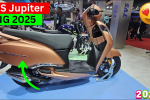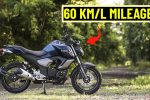
In a motorcycle market increasingly dominated by modern designs and cutting-edge technology, the Jawa 42 Bobber stands as a refreshing anomaly—a machine that pays homage to motorcycling’s rich heritage while incorporating just enough contemporary elements to remain relevant. This intriguing blend of old-school aesthetics and modern engineering has captured the attention of riders seeking something beyond the ordinary, making the 42 Bobber one of the most distinctive offerings in Jawa’s resurgent lineup.
A Design That Demands Attention
The Jawa 42 Bobber takes the minimalist bobber ethos and infuses it with the brand’s signature retro DNA. True to bobber tradition, the motorcycle features a stripped-down design with a single floating seat, chopped fenders, and a low-slung profile that creates an unmistakable silhouette. The round headlamp, teardrop fuel tank, and liberal use of chrome accents pay tribute to motorcycling’s golden era, while modern LED lighting and contemporary color schemes inject a dose of present-day appeal.
Unlike many bobbers that can appear overly austere, the 42 Bobber manages to maintain visual interest through thoughtful details. The offset speedometer, bar-end mirrors, and distinctive tank badges create focal points that draw the eye, while the blacked-out engine with machined cooling fins provides an appealing mechanical centerpiece. The floating solo seat—perhaps the motorcycle’s most defining visual element—appears to hover above the rear fender, reinforcing the custom-built aesthetic that bobbers have long embodied.
Available in three distinctive colorways—Mystic Copper, Jasper Red, and Moonstone White—the 42 Bobber allows for personal expression while maintaining its fundamental design character. Practical customization is further enabled through a range of official accessories, including different seat options, alternative handlebars, and various trim pieces that allow owners to tailor the motorcycle to their preferences.
Engineering and Performance: More Than Just Looks
Beneath its nostalgic exterior, the Jawa 42 Bobber features a thoroughly modern powertrain. The liquid-cooled, single-cylinder 334cc engine produces 30.64 PS of maximum power and 32.74 Nm of peak torque—respectable figures that provide adequate performance for both urban riding and highway cruising. The fuel-injected powerplant meets the latest BS6 Phase 2 emission standards without sacrificing the distinctive exhaust note that Jawa enthusiasts have come to appreciate.
Power delivery is channeled through a 6-speed transmission with a slip-and-assist clutch, making gear changes smoother and reducing clutch effort in stop-and-go traffic. The engine’s character suits the bobber ethos well, with accessible low-end torque that enables relaxed riding rather than demanding constant gear changes to maintain momentum.
The chassis combines a double-cradle frame with conventional telescopic forks at the front and twin shock absorbers at the rear. While not cutting-edge, this setup provides predictable handling and a ride quality that balances feedback with comfort. The 13-liter fuel tank offers a practical range of approximately 350-400 kilometers, making weekend escapes entirely feasible.
Technical Specifications
| Specification | Details |
|---|---|
| Engine | 334cc, single-cylinder, liquid-cooled, DOHC |
| Maximum Power | 30.64 PS @ 8000 rpm |
| Maximum Torque | 32.74 Nm @ 6500 rpm |
| Transmission | 6-speed with slip-and-assist clutch |
| Fuel System | Electronic fuel injection |
| Front Suspension | Telescopic forks, 120mm travel |
| Rear Suspension | Twin shock absorbers, 5-step preload adjustable |
| Front Brake | 280mm disc with floating caliper |
| Rear Brake | 240mm disc |
| ABS | Dual-channel ABS |
| Front Tire | 100/90-18 |
| Rear Tire | 140/70-17 |
| Seat Height | 740 mm |
| Ground Clearance | 165 mm |
| Kerb Weight | 185 kg |
| Fuel Tank Capacity | 13 liters |
| Fuel Efficiency | 26-30 km/l (approximate) |
Riding Experience: Character Over Outright Performance
The Jawa 42 Bobber isn’t designed to win specification sheet comparisons or set lap records. Instead, it focuses on delivering a distinctive riding experience that emphasizes character over outright performance. The low seat height of 740mm makes it accessible to riders of various statures, while the forward-set footpegs and wide handlebars create a relaxed riding position ideal for cruising.
In urban environments, the motorcycle’s lightweight nature and responsive throttle make it easy to navigate through traffic. The tight turning radius is particularly beneficial when maneuvering in congested areas, while the commanding riding position provides good visibility of surrounding traffic. The engine’s torquey character reduces the need for frequent gear changes, contributing to a more relaxed city riding experience.
On open roads, the 42 Bobber settles into a comfortable cruising rhythm. The sweet spot lies between 80-100 km/h, where the engine runs smoothly and vibrations are kept to a minimum. Push beyond this range, and some vibrations begin to make themselves felt through the handlebars and footpegs—a reminder that this is a motorcycle built for enjoyment rather than outright speed.
Corner carving isn’t the 42 Bobber’s primary mission, but it handles sweeping bends with composure. The relatively low center of gravity helps inspire confidence, while the tractable engine allows for easy mid-corner adjustments. More aggressive riding will eventually highlight the limited ground clearance and suspension travel, but these characteristics are consistent with the bobber genre.
Comfort and Practicality: Surprising Utility
Despite its focus on style, the Jawa 42 Bobber offers surprising practicality for daily use. The single seat, while appearing minimalist, provides adequate comfort for rides of 1-2 hours before a break becomes desirable. For longer journeys, Jawa offers a more padded comfort seat as an accessory option.
The 13-liter fuel tank combined with the relatively efficient engine provides a useful range of approximately 350-400 kilometers, reducing the frequency of refueling stops on longer rides. The 165mm ground clearance is sufficient for navigating typical urban obstacles and minor road imperfections, though care is needed on more challenging surfaces.
Storage is understandably limited given the motorcycle’s design focus, but Jawa offers accessory saddlebags that can be fitted without compromising the bobber aesthetic. The digital-analog instrument cluster provides essential information including speed, fuel level, odometer, and trip meters, while a USB charging port allows for keeping mobile devices powered on longer journeys.
Features and Equipment
| Category | Equipment |
|---|---|
| Lighting | LED headlamp, LED tail lamp, LED turn indicators |
| Instrumentation | Digital-analog cluster with speedometer, fuel gauge, odometer, trip meters |
| Safety | Dual-channel ABS, hazard lights |
| Convenience | USB charging port, tool kit |
| Standard Equipment | Bar-end mirrors, floating solo seat, blacked-out engine components |
| Optional Accessories | Comfort seat, saddlebags, windscreen, alternative handlebars, engine crash guard |
Price and Variant Structure
The Jawa 42 Bobber follows a straightforward pricing strategy with three variants distinguished primarily by color options and minor cosmetic differences. This approach simplifies the buying decision while still offering some degree of personalization.
Variant Pricing
| Variant | Price (Ex-showroom) | Key Features |
|---|---|---|
| 42 Bobber Mystic Copper | ₹2,12,900 | Copper finish with matte black accents, black spoke wheels |
| 42 Bobber Jasper Red | ₹2,14,900 | Deep red finish with chrome accents, blacked-out engine |
| 42 Bobber Moonstone White | ₹2,14,900 | Pearl white finish with chrome details, premium seat material |
All variants share identical mechanical components and technical specifications, with differences limited to cosmetic elements. The relatively small price difference between variants makes the choice primarily a matter of aesthetic preference rather than value consideration.
Ownership Experience: A Growing Community
Beyond the motorcycle itself, owning a Jawa 42 Bobber offers entry into a passionate community of enthusiasts. Jawa owners frequently organize rides and meetups, creating a social dimension to ownership that many find as rewarding as the riding experience itself. The brand actively fosters this community through organized events, rides, and social media engagement.
Jawa provides a standard warranty of 2 years/unlimited kilometers, with extended warranty packages available at additional cost. Service intervals are set at every 6 months or 5,000 kilometers, whichever comes first. With over 300 dealerships across the country, finding service support is relatively convenient in most urban and many semi-urban areas.
Maintenance costs remain competitive for the segment, with service costs averaging ₹1,500-2,500 for routine maintenance. The relatively simple mechanical design means that many basic maintenance tasks can be performed by owners with basic mechanical knowledge, though more complex operations still require dealer intervention.
Market Positioning: A Distinctive Proposition
In the mid-displacement motorcycle segment, the Jawa 42 Bobber occupies a unique position. While Royal Enfield dominates the retro motorcycle space with models like the Classic 350 and Meteor 350, the 42 Bobber offers a distinctly different aesthetic and riding experience. Its closest competitor is perhaps the Benelli Imperiale 400, though that motorcycle leans more toward a conventional classic design rather than the bobber style.
The 42 Bobber’s pricing positions it as a premium offering within its displacement category, justified by its distinctive design, relatively low production volumes, and the heritage appeal of the Jawa brand. For buyers, the decision often comes down to how much they value uniqueness and the bobber aesthetic over raw performance metrics.
Conclusion: Character in an Age of Conformity
In an era where motorcycles increasingly compete on technical specifications and feature lists, the Jawa 42 Bobber offers something less tangible but perhaps more valuable—character. Its blend of classic bobber aesthetics with modernized mechanicals creates a motorcycle that stands apart from mainstream offerings, appealing to riders who prioritize distinctiveness and emotional connection over outright performance.
The 42 Bobber won’t be the right motorcycle for everyone. Those seeking maximum performance for their money, cutting-edge technology, or ultimate practicality will likely be better served elsewhere. But for riders drawn to its unique design philosophy and the heritage of the Jawa brand, the 42 Bobber delivers a compelling package that few competitors can match—a motorcycle with authentic personality in an increasingly homogenized market.
Frequently Asked Questions
Q: How does the Jawa 42 Bobber compare to the standard Jawa 42 in terms of performance and handling? A: The 42 Bobber shares the same engine as the standard 42 but features different ergonomics with a lower seat height, forward-set footpegs, and altered weight distribution that prioritizes cruising comfort over sporty handling.
Q: Is the single seat on the Jawa 42 Bobber comfortable for longer rides? A: The standard seat provides adequate comfort for 1-2 hour rides, while Jawa offers a more padded comfort seat as an accessory for riders planning longer journeys.
Q: Does the Jawa 42 Bobber require premium fuel? A: The motorcycle is designed to run on regular 91-octane fuel, though some owners report slightly improved performance with premium fuel.
Q: Can the Jawa 42 Bobber be converted to accommodate a passenger? A: Yes, Jawa offers an official accessory pillion seat kit that can be installed, though this modification somewhat compromises the pure bobber aesthetic.



